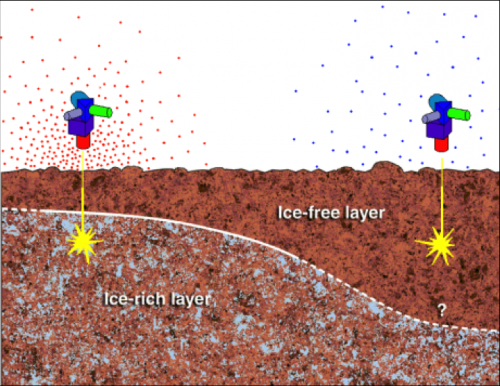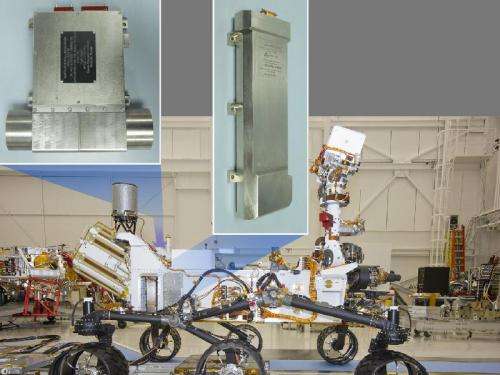Update from Curiosity: Gale Crater might be drier than expected

(Phys.org)—Preliminary data from the Curiosity Mars Science Laboratory, presented at the European Planetary Science Conference on 28 September, indicate that the Gale Crater landing site might be drier than expected.
The Curiosity rover is designed to carry out research into whether Mars was ever able to support life, and a key element of this search is the hunt for water. Although Mars has many features on its surface that suggest a distant past in which the planet had abundant liquid water in the form of rivers and lakes, the only water known to be abundant on Mars today is frozen, embedded in the soil, and in large ice caps at both poles.
The Dynamic Albedo of Neutrons (DAN) instrument on board Curiosity is designed to detect the location and abundance of water thanks to the way hydrogen (one of water's components) reflects neutrons. When neutrons hit heavy particles, they bounce off with little loss in energy, but when they hit hydrogen atoms (which are much lighter and have approximately the same mass as neutrons), they lose half of their energy.
The DAN instrument works by firing a pulse of neutrons at the ground beneath the rover and detecting the way it is reflected. The intensity of the reflection depends on the proportion of water in the ground, while the time the pulse takes to reach the detector is a function of the depth at which the water is located.

"The prediction based on previous measurements using the Mars Odyssey orbiter was that the soil in Gale Crater would be around 6% water. But the preliminary results from Curiosity show only a fraction of this," said Maxim Mokrousov (Russian Space Research Institute), the lead designer of the instrument.
One possible explanation of the discrepancy lies in the variability of water content across the surface of Mars. There are large-scale variations, with polar regions in particular having high abundances of water, but also substantial local differences even within individual regions on Mars.
The Mars Odyssey spacecraft is only able to measure water abundance for an area around 300 by 300 kilometres – it cannot make high resolution maps. It may therefore be that Odyssey's figure for Gale Crater is an accurate (but somewhat misleading) average of significantly varying hydrogen abundances in different parts the crater.
Indeed, over the small distance that the rover has already covered, DAN has observed variations in the detector counting rates that may indicate different levels of hydrogen in the ground, hinting that this is likely to be the case.
Curiosity's ability to probe the water content in the martian soil in specific locations, rather than averages of broad regions, allows for a far more precise and detailed understanding of the distribution of water ice on Mars.
Provided by Europlanet




















